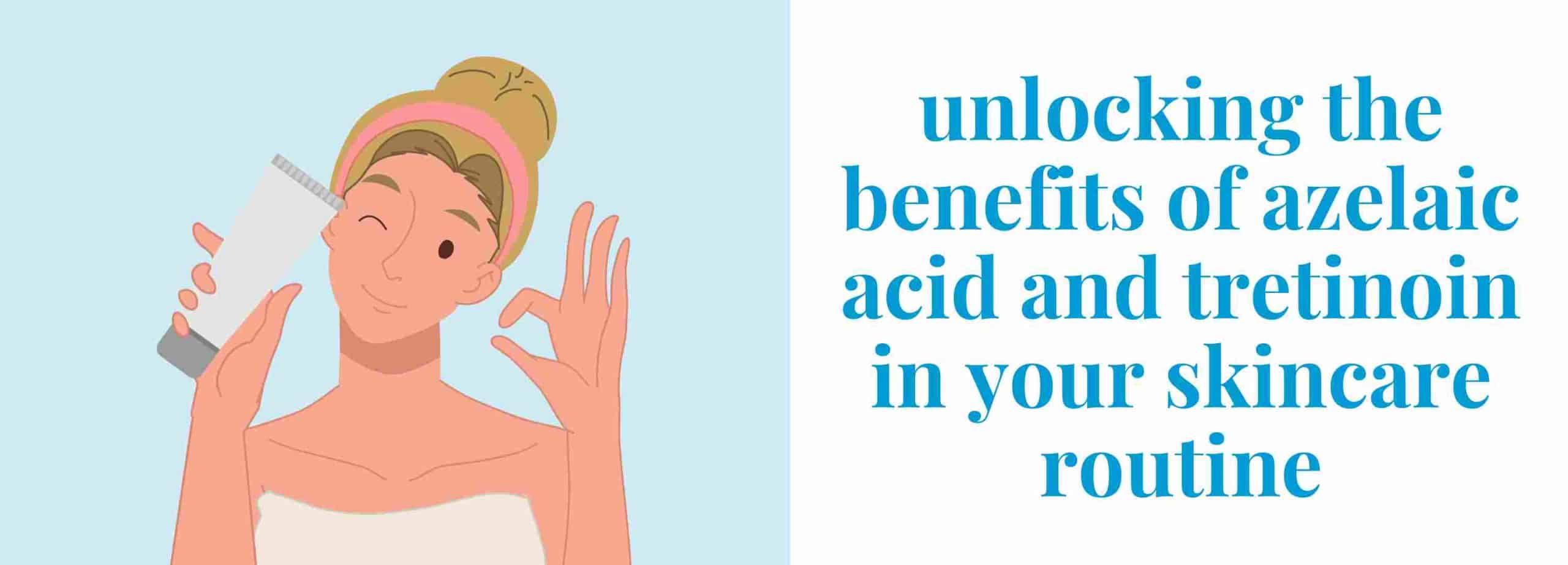Medically reviewed by Sophia Yen, MD, MPH
Azelaic acid and tretinoin individually are powerful acne-fighting and anti-aging prescription medications. Combined, they’re twice as strong.
We know how overwhelming it can be to navigate the world of skincare and acne treatments, but don’t worry, we’re here to help! If you’re on the hunt for some seriously effective ingredients to add to your routine, azelaic acid and tretinoin might be just what you need. These two powerhouses can work wonders for your skin.
In this article, we’ll guide you through the benefits of these ingredients and show you exactly how to incorporate them into your routine. And don’t worry, we’ll also give you the scoop on any potential side effects to look out for. With azelaic acid and tretinoin on your team, you can be well on your way to healthy, radiant skin!

What is Azelaic Acid?
Azelaic acid is a topical medication that’s used to treat mild to moderate acne. It’s a naturally occurring dicarboxylic acid derived from grains like wheat and barley. In cosmetic formulas, azelaic acid is made synthetically. It’s used for its anti-microbial and anti-inflammatory properties and can help treat a wide range of skin concerns like acne and rosacea.
You can get azelaic acid in creams, gels, and foams. Lower doses are available over the counter, but you need a prescription for higher doses.
Benefits of Azelaic Acid
Azelaic acid is a skincare option that offers many benefits. It can help treat acne, improve skin texture, reduce hyperpigmentation and fine lines, and regulate sebum production. With anti-inflammatory properties, it can also help reduce redness and sensitivity, making it a relatively safe option for all skin types.
Side Effects of Azelaic Acid
Like all medications, azelaic acid can cause side effects, although not everyone will experience them. Some of the most common side effects include:
- Skin irritation: This can include redness, itching, burning, and stinging. These side effects are usually mild and go away on their own.
- Dry skin: Azelaic acid can cause your skin to become dry and flaky. You can alleviate this by using a moisturizer.
- Discoloration: Azelaic acid can cause changes in skin color, particularly in people with darker skin.
- Allergic reaction: Some people may experience an allergic reaction to azelaic acid, which can include hives, swelling, and difficulty breathing. If you experience any of these symptoms, call 911 and/or go to the ER.
It is important to note that these side effects are usually mild and go away on their own. If you experience any severe side effects or are concerned about the side effects you are experiencing, talk to your doctor.
How to Apply Azelaic Acid
Generally, the recommendation for ages 12 and up is to apply a thin layer of azelaic acid twice daily.
Order Azelaic Acid from Pandia Health and Get Free Delivery
Get Azelaic Acid with free delivery from Pandia Health! Simply get a telehealth evaluation with one of our board-certified doctors, and get your prescription with free delivery!
What is Tretinoin?
Tretinoin is a medication that belongs to a class of drugs called retinoids. It is a form of vitamin A that is used topically to treat a variety of skin conditions, including acne, fine wrinkles, hyperpigmentation, and rough skin texture.
Tretinoin works by increasing cell turnover, decreasing pore size, decreasing sebum (oil) production, which helps to improve skin appearance and texture. It is available in various forms, including creams and gels.
Benefits of Tretinoin
Tretinoin offers a range of benefits when used as directed by a healthcare professional:
- Treat acne: Tretinoin is a commonly prescribed medication for the treatment of acne. It works by unclogging pores, reducing inflammation, and preventing new acne breakouts.
- Reduce fine lines and wrinkles: Tretinoin can help reduce the appearance of fine lines and wrinkles by increasing collagen production and accelerating skin cell turnover.
- Improve skin texture and tone: Tretinoin can improve skin texture and tone by smoothing rough skin, reducing hyperpigmentation, and promoting even skin tone.
It is important to note that tretinoin should only be used under the guidance of a healthcare professional and that it may not be suitable for everyone. Talk to your doctor or an expert doctor at Pandia Health to determine if tretinoin is right for you.
Side effects of Tretinoin
While it can work wonders, tretinoin can also cause some side effects, so we need to be cautious and follow your doctor’s instructions closely
Common side effects from using tretinoin include:
- Burning, itching, stinging, scaling, or redness of the skin
- Slight peeling of the skin
- Darkening of the skin
- Lightening of skin
- Lightening of treated areas of dark skin
- Redness of skin
- Unusual dryness of skin
- Unusually warm skin
If you get any of these symptoms: burning, itching or stinging talk to your doctor ASAP.
When using tretinoin, it’s important to wear SPF every day because your skin will be more sensitive to the sun, and you risk incurring more sun damage.
How to apply tretinoin
Tretinoin should be applied at night. Here are some general guidelines to follow when applying tretinoin that doctors say will help minimize your risk of irritation:
-
1. Cleanse your face with a gentle cleanser. Pat dry.
-
2. Apply a small amount of tretinoin in a thin layer (no more than a pea-size for your entire face).If you use more tretinoin than recommended in hopes that it will work faster — know that it won’t. You’ll just be left with irritated, chafed skin.
-
3. After applying your tretinoin, apply a good-quality, water-based moisturizer. This will help prevent dryness and flaking.
If you experience flaking, don’t pick at it. You can use a gentle scrub to wash your face. Just keep moisturizing!
If you find that your skin isn’t tolerating tretinoin well when used every night, you could try applying it every second or third night and work up as you’re able to.
Order Tretinoin Online from Pandia Health
If you’re struggling with acne and are interested in trying tretinoin, our expert doctors at Pandia Health are here to guide you. You can buy tretinoin online with a prescription from our doctors. And your prescription ships right to your door with free delivery, for ultimate convenience!
Can You Use Azelaic Acid and Tretinoin Together?
So, can you use azelaic acid and tretinoin cream together? Doctors say that absolutely, you can. The two ingredients work well together.
When used to treat acne, azelaic acid may enhance the effects of tretinoin. Both medications are anti-inflammatory, antimicrobial, and have antioxidant properties. When azelaic acid and tretinoin are used together, doctors have found that they may work even better at correcting melasma — or dark patches and spots — than they do when they’re used separately.
Risks of mixing Azelaic Acid and Retinol
Mixing medications always comes with risks. Both azelaic acid and tretinoin may cause side effects on their own.
Studies show that the risk of side effects does not usually increase by too much when the two medications are combined, however, your skin could experience some sensitivity, dryness, and redness.
If you experience unwanted or severe side effects from combining azelaic acid and tretinoin, consult your doctor immediately.
How to Layer Azelaic Acid and Tretinoin
If you’re combining azelaic acid and tretinoin, you might be wondering which should be applied first. Since both ingredients can come in similar consistencies — creams and gels — knowing which goes on your skin first can be tough. Here is a step-by-step guide:
-
1. Cleanse your face with a gentle cleanser. Pat dry.
-
2. In the morning, apply your azelaic acid and follow with moisturizer and SPF. Don’t use tretinoin in the morning, as it makes your skin more sensitive to the sun and is less effective when exposed to sunlight.
-
3. At night, apply your tretinoin, followed by azelaic acid, and then moisturizer. As long as you follow the instructions from your medical provider, tretinoin and azelaic acid are usually safe to use together.
Unlock the Ultimate Skincare Routine With Pandia Health
If you’re struggling with acne and are interested in trying azelaic acid and tretinoin together, or if you want to try one ingredient on its own, Pandia Health is here to help.
Our board-certified doctors are trusted acne-care experts who have helped many people just like you overcome their battle with acne. Our doctors can answer any questions you have about how to use your acne treatments so you can get the best possible results. Once you have a prescription from our doctors, you’ll get it with free delivery straight to your mailbox, with goodies included! Take the first step towards clearing up your acne and get started with Pandia Health today!
Pandia Health is dedicated to providing accurate, reliable women’s health knowledge. Connect with Pandia Health on TikTok, Youtube, Instagram, and Facebook to get expert insights on acne treatments and women’s health.
Disclaimer: This article is for general informational purposes and is NOT a substitute for professional medical advice. Always seek the advice of your healthcare provider before starting or changing acne treatment.


